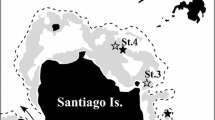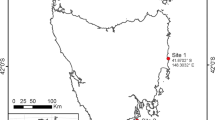Abstract
We studied biomass and macronutrient content ofHalodule wrightii (shoalgrass) throughout the winter and ofThalassia testudinum (turtlegrass) andSyringodium filiforme (manateegrass) in January in Chandeleur Sound, LouisianaHalodule, the primary fcod of wintering redheads, had the lowest biomass of the three species on the study area in mid-winter. Macronutrient content ofHalodule did not change during the winter, but aboveground and belowground biomass showed a 90 and 49% (P<0.0001) decrease from October to March. Macronutrient content seems not to be the basis for selection by redheads ofHalodule over the other two seagrass species or of selection of belowground over aboveground parts.
Similar content being viewed by others
Literature Cited
Association of Official Analytical Chemists. 1985. Official Methods of Analysis. 14th ed. Association of Official Analytical Chemists, Washington, DC, USA.
Bailey, R. O. and R. D. Titman. 1984. Habitat use and feeding ecology of postbreeding redheads. Journal of Wildlife Management 48:1144–1155.
Bartonek, J. C. and J. J. Hickey. 1969. Food habits of canvasbacks, redheads, and lessen scaup in Manitoba. Condor 71:280–290.
Bellrose, F. C. 1980. Ducks, Geese and Swans of North America. Stackpole Books, Harrisburg, PA, USA.
Bergman, R. D. 1973. Use of southern boreal lakes by postbreeding canvasbacks and redheads. Journal of Wildlife Management 37: 160–170.
Buchsbaum, R., J. Wilson, and I. Valiela. 1986. Digestibility of plant constituents by Canada geese and Atlantic brant. Ecology 67:386–393.
Clark, R. G., H. Greenwood, and L. G. Sugden. 1986. Influence of grain characteristics on optimal diet of field-feeding mallards (Anas platyrhynchos). Journal of Applied Ecology 23:763–771.
Cornelius, S. E. 1975. Food choice of wintering redhead ducks (Aythya Americana) and utilization of available resources in lower Laguna Madre, Texas. M.S. Thesis. Texas A&M University, College Station, TX, USA.
Cornelius, S. E. 1977. Food and resource utilization by wintering redheads on Lower Laguna Madre. Journal of Wildlife Management 41:374–385.
Correll, D. S. and H. B. Correll. 1975. Aquatic and wetland plants of the southwestern United States, vol. 1. Stanford University Press, Stanford, CA, USA.
Cowardin, L. M., V. Carter, F. C. Golet, and E. T. LaRoe. 1979. Classification of Wetlands and Deepwater Habitats of the United States. U.S. Fish and Wildlife Service, Office of Biological Services, Washington, DC, USA. FWS/OBS-79/31.
Dawes, C. J. 1987. The dynamic seagrasses of the Gulf of Mexico and Florida coast. p. 25–38.In M. Durako, R. Phillips, and R. Lewis (eds.) Proceedings of the Symposium on Subtropical-Tropical Seagrasses of the Southeastern U.S., Florida Marine Research Publication 42.
Dawes, C. J. and J. M. Lawrence. 1980. Seasonal change in the proximate constituents of the seagrasses,Thalassia testudinum, Halodule wrightii, andSyringodium filiforme. Aquatic Botany 8:371–380.
Day, R. W. and G. P. Quinn. 1989. Comparisons of treatments after an analysis of variance in ecology. Ecological Monographs 58:433–463.
Fox, A. D. 1993. Pre-nesting feeding selectivity of pink-footed geeseAnser brachyrhynchus in artificial grasslands. Ibis 135:417–423.
Gidden, C. S. 1965. A study of the vegetation in the closed area of Apalachee Bay. Typewritten report, U. S. Fish and Wildlife Service, Regional Office, Atlanta, GA, USA.
Iverson, R. L. and J. E. Bittaker. 1986. Seagrass distribution in the eastern Gulf of Mexico. Estuarine Coastal Shelf Science 22: 577–602.
Jarvis, R. L. and J. H. Noyes. 1986. Foods of canvasbacks and redheads in Nevada: paired males and ducklings. Journal of Wildlife Management 50:199–203.
Lagerquist, B. A. and C. D. Ankney. 1989. Interspecific differences in bill and tongue morphology among diving ducks (Aythya spp.,Oxyura jamaicensis). Canadian Journal of Zoology 67:2694–2699.
Lovvorn, J. R. 1994. Biomechanics and foraging profitability: an approach to assessing trophic needs and impacts of diving ducks. Hydrobiologia 279/280:223–233.
Lowry, G., N. M. Rosenbrough, A. L. Farr, and R. J. Randall. 1951. Protein measurement with the Folin phenol reagent. Journal of Biological Chemistry 193:265–275.
McMahan, C. A. 1970. Food habits of duck wintering on Laguna Madre, Texas. Journal of Wildlife Management 34:946–949.
Michot, T. C. and A. J. Nault. 1993. Diet differences in redheads from nearshore and offshore zones in Louisiana. Journal of Wildlife Management 57:238–244.
Michot, T. C., E. B. Moser, and W. Norling. 1994. Effects of weather and tides on feeding and flock positions of wintering redheads in the Chandeleur Sound, Louisiana. Hydrobiologia 279/280:263–278.
Miller, M. R. 1987. Fall and winter foods of northern pintails in the Sacramento Valley, California. Journal of Wildlife Management 51:405–414.
Mitchell, C. A. 1992. Water depth predicts redhead distribution in the lower Laguna Madre, Texas. Wildlife Society Bulletin 20: 420–424.
Mitchell, C. A., T. W. Custer, and P. J. Zwank. 1992. Redhead duck behavior on lower Laguna Madre and adjacent ponds of south Texas. Southwestern Naturalist 37:65–72.
Mitchell, C. A., T. W. Custer, and P. J. Zwank. 1994. Herbivory on shoalgrass by wintering redheads in Texas. Journal of Wildlife Management 58:131–141.
Noyes, J. H. and R. L. Jarvis. 1985. Diet and nutrition of breeding female redhead and canvasback ducks in Nevada. Journal of Wildlife Management 49:203–211.
Perry, M. C. and F. M. Uhler. 1982. Food habits of diving ducks in the Carolinas. Proceedings of the Annual Conference of the Southeastern Association of Fish and Wildlife Agencies 36:492–504.
Phillips, V. E. 1991. PochardAythya ferina use of chironomidrich feeding habitat in winter. Bird Study 38:118–122.
Phillipson, J. 1964. A miniature bomb calorimeter for small biological samples. Oikos 15:131–139.
Pyke, G. H., H. R. Pulliam, and E. L. Charnov. 1977. Optimal foraging: a selective review of theory and tests. Quarterly Review of Biology 52:137–154.
Saunders, G. B. and D. C. Saunders. 1981. Waterfowl and their wintering grounds in Mexico. U.S. Fish and Wildlife Service. Washington, DC, USA. Resource Publicatio 138.
SAS Institute, Inc., 1987. SAS/STAT Guide for Personal Computers, SAS Institute, Inc., Cary, NC, USA.
Sedinger, J. S. 1984. Protein and amino acid composition of tundra vegetation in relation to nutritional requirements of geese. Journal of Wildlife Management 48:1128–1136.
Sedinger, J. S. and D. G. Raveling. 1984. Dietary selectivity in relation to availability and quality of food for goslings of cackling geese. Auk 101:295–306.
Sedinger, J. S., R. G. White, F. E. Mann, F. A. Burris, and R. A. Kedrowski. 1989. Apparent metabolizability of alfalfa components by yearling pacific black brant. Journal of Wildlife Management 53:726–734.
Stephenson, R., J. R. Lovvorn, M. R. A. Heieis, D. R. Jones, and R. W. Blake. 1989. A hydromechanical estimate of the power requirements of diving and surface swimming in lesser scaup (Aythya affinis). Journal of Experimental Biology 147:507–518.
Stieglitz, W. O. 1966. Utilization of available foods by diving ducks on Apalachee Bay. Florida. Proceedings of the Southeastern Association of Game and Fish Commissioners 20:42–50.
Thomas, V. G. and J. P. Prevett. 1980. The nutritional value of arrow-grasses to geese at James Bay. Journal of Wildlife Management 44:830–836.
Van Soest, P. J. 1963. Use of detergents in the analysis of fibrous feeds. II. A rapid method for determination of fiber and lignin. Journal of the Association of Official Agricultural Chemists 46: 829–835.
Van Soest, P. J. 1982. Nutritional Ecology of the Ruminant. O. and B. Books, Inc., Corvalis, OR, USA.
Woodin, M. C. and G. A. Swanson. 1989. Foods and dietary strategies of prairie-nesting ruddy ducks and redheads. Condor 91: 280–287.
Zieman, J. C. and R. T. Zieman. 1989. The Ecology of the Seagrass Meadows of the West Coast of Florida: A Community Profile. U.S. Fish and Wildlife Service, Washington, DC, USA. Biological Report 85.
Author information
Authors and Affiliations
Rights and permissions
About this article
Cite this article
Michot, T.C., Chadwick, P.C. Winter biomass and nutrient values of three seagrass species as potential foods for redheads (Aythya americana eyton) in Chandeleur Sound, Louisiana. Wetlands 14, 276–283 (1994). https://doi.org/10.1007/BF03160633
Received:
Revised:
Accepted:
Issue Date:
DOI: https://doi.org/10.1007/BF03160633




